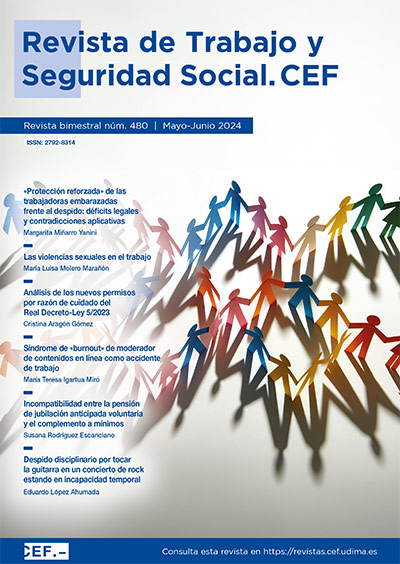Spanish Strategy for Health and Safety at Work 2023-2027 from a gender perspective
DOI:
https://doi.org/10.51302/rtss.2024.21485Keywords:
Spanish Strategy for Health and Safety at Work 2023-2027, gender perspective, risks prevention at work, working conditions, security and health at work, gender differences, labor segregation, gender perspective integrationAbstract
The distribution of tasks and responsibilities by gender can have a different impact on working men and women. Therefore, effective and preventive action must identify the different implications for women and men depending on their exposure to risks with the current living conditions and establish specific prevention strategies that incorporate the needs of women, taking into account the situations of inequality and discrimination that exist in the workplace and life in general. With this goal and having in mind the increase in women’s participation in the working market, the integration of the gender dimension in safety and health policies constitutes one of the priorities of the Spanish Strategy for Health and Safety at Work. 2023-2027.
This study starts with the analysis of the differences that exist in the occupational health and safety policy concerning gender and the causes of these differences, to highlight the lines of action planned in the Spanish Strategy to introduce the gender perspective into all areas of occupational health and safety, to achieve equality and improve the working conditions of women.
Supporting Agencies
Este estudio tiene su origen en la ponencia impartida en la jornada sobre «Análisis de las Reformas Legales 2022-2023 desde una perspectiva de género», el 26 de octubre de 2023, en la Universidad Rey Juan Carlos y se realiza dentro del marco del Proyecto puente de Investigación sobre «Ser mujer y trabajo en la era digital» (Ref. 2023/SOLCON-130825).
Downloads
References
Comisión Europea, Dirección General de Empleo, Asuntos Sociales e Inclusión (2011). Coste socioeconómico de los accidentes de trabajo y la mala salud relacionada con el trabajo, informe final.
INE (2023). Encuesta de población activa (EPA) y Estadística de Flujos de la Población Activa (EFPA). Tercer trimestre de 2023. https://www.ine.es/daco/daco42/daco4211/epa0323.pdf
INSST (2023a). Accidentes de trabajo con baja en jornada de trabajo (ATJT), según sexo y edad. https://www.insst.es/el-observatorio/indicadores-evolutivos/accidentes-de-trabajo-y-otros-danos-a-la-salud/accidentes-de-trabajo-con-baja-en-jornada-de-trabajo-atjt-segun-sexo-y-edad
INSST (2023b). Informe anual de accidentes de trabajo en España 2022. https://www.insst.es/documents/94886/376820/Informe%20anual%20de%20accidentes%20de%20trabajo%20en%20Espa%C3%B1a%202022.pdf/5405dfb6-d494-f0fb-7f27-7db956d49da4?version=1.0&t=1693395553437
Ministerio de Sanidad (2022). Estrategia de salud mental del Sistema Nacional de Salud 2023-2026.https://www.sanidad.gob.es/areas/calidadAsistencial/estrategias/saludMental/docs/Ministerio_Sanidad_Estrategia_Salud_Mental_SNS_2022_2026.pdf
MITES (2023). Estadística de Accidentes de Trabajo. Avance enero-febrero 2023. https://www.mites.gob.es/estadisticas/eat/eat23_02/ATR_02_2023_Resumen.pdf
Observatorio de Enfermedades Profesionales –CEPROSS– y de Enfermedades Causadas o Agravadas por el Trabajo –PANOTRATSS– (2023). Informe anual 2022.
Viña Cruz, S. (2023). Desafíos del tiempo de trabajo en la era digital: especial referencia a la perspectiva de género en la Estrategia Española de Seguridad y Salud en el Trabajo 2023-2027. Revista de Derecho Social, 104, 73-98.


















